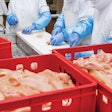
Processing can be seen as starting once chickens have reached the required weight and are ready to be dispatched to the processing plant.
At this point, feed withdrawal must be implemented to empty the intestines of fecal matter in order to prevent contamination during evisceration, which can impact the safety of the carcass before entering the prechiller.
Feed withdrawal starts with the withholding of feed some 8-12 hours pre-slaughter, but for feed withdrawal to be fully successful, a number of factors must be considered and actions carried out.
These include:
- Ensuring that there is a fully functioning water supply in all drinkers. Water moistens any feed that has already been ingested, helping to facilitate its movement through the digestive tract.
- If feed withdrawal is carried out at night, the lights must be kept on, to stop the birds laying down and sleeping.
- Chickens must be kept active. This action also encourages the movement of feed through the digestive tract.
- Catching of birds should be carried out within five hours from the start of feed withdrawal.
Five hours is the period that has been shown to be most effective to ensure ingested feed has been excreted. Whenever possible, this period should be rigidly adhered to as it has an impact on the subsequent stages of processing.
Additionally, catching, caging, transport and storage at the plant pre-slaughter all have an impact on the cleaning of the intestinal tract.
When birds are caught, they go into shock for several minutes until settled into cages. This alters their metabolism, slowing their ability to absorb nutrients from feed.
Once birds lay down in their cages, the crop, proventriculus and gizzard are in direct contact with the floor of the cage. This puts pressure on these organs, preventing the passage of feed through the digestive tract.
As cages are unloaded into the waiting area, close to the area for hanging on the overhead conveyor, birds experience more stress, and this also disturbs digestion.
In the daily operation of today’s poultry industry, there are two diametrically opposed situations that can occur with feed withdrawal:
- Insufficient feed withdrawal – less than 8 hours
- Prolonged feed withdrawal – in excess of 12 hours
Both approaches have their own characteristics and impact on the quality, safety and yield of processed chickens.
Insufficient feed withdrawal
Catching takes place approximately just two hours after feeding has been stopped, and it is for this reason that feed can still be found in the crop proventriculus and gizzard.
At plucking, the crop still contains feed. During evisceration, the proventriculus is found to be full of feed, and on opening the gizzard, much feed is also evident.
What are the effects on processing?
Birds are not processed with an accurately known weight, as remaining feed must be removed and sent to the rendering plant. For this reason, the weights of birds may not be in line with what is required by the sales department.
There is a financial loss, as the last feed fed is not transformed into flesh. There is also a high risk of contamination should the crop break during evisceration.
Prolonged feed withdrawal
The intestines are composed of three layers. During the withdrawal period, the inner layers – the mucosa and submucosa - start to be excreted, increasing the fragility of the intestines during evisceration. In the storage area where chickens are kept prior to processing, feces will be found with traces of intestinal tissue that look like small tomato skins.
During digestion birds have three reverse peristalsis actions, there are from:
- The gizzard, proventriculus into the crop
- Small intestine, gizzard to the crop
- Large intestine to caecum
As the gizzard is the coordinator of digestion, during long feed withdrawal, the internal cutica gastrica hardens, and become stained due to the passage of bile. Because of this hardening, more pressure must be applied by the gizzard peeling rollers to remove it. This results in the removal of more meat, affecting yield by an average of at least 20%. For example, if a plant processes 100,000 birds each day, and it is assumed that 20% of birds have been through a long feed withdrawal. The weight of the processed gizzard without proventriculus and fat is approximately 22 grams. If the daily loss is 88 kg or 27.5 tons per year, then this becomes a significant financial loss.
In addition, during the period prior to slaughter, a chicken’s organs continue to function normally, and the liver continues to produce bile. This passes through the first part of the duodenum, the small intestine, through the two bile ducts, one of which expands into the gallbladder. As bile is produced, the walls of the gallbladder expand and become fragile. Once it has reached capacity, reverse peristalsis occurs and bile can reach the crop. Some bile travels to the liver, and this can affect the taste of the liver.
During evisceration, the removal of the gallbladder from the liver can lead to damage, as the tissues are very fragile. This can lead to bleeding into the internal cavity. If not washed within the following 20 seconds, the result is permanent staining and these carcasses will no longer be Grade A.
With long feed withdrawal, the liver, which is the chicken’s energy bank, can shrink and darken, as both glucose and fat are gradually consumed over the long withdrawal period. Consequently, there is a loss of yield.
Lastly, as a result of the dehydration that occurs, the crop becomes firmly attached to the abdominal cavity. As a consequence, greater effort is required during manual removal. If poorly performed, residues can be left behind and due to the subsequent need for them to be removed, there can be delays in the packing process and resulting bottlenecks.
In short, a proper consideration of feed withdrawal will speed up processing, regardless of the number of chickens slaughtered each day, and will improve the quality, safety and yield of processed chickens.















